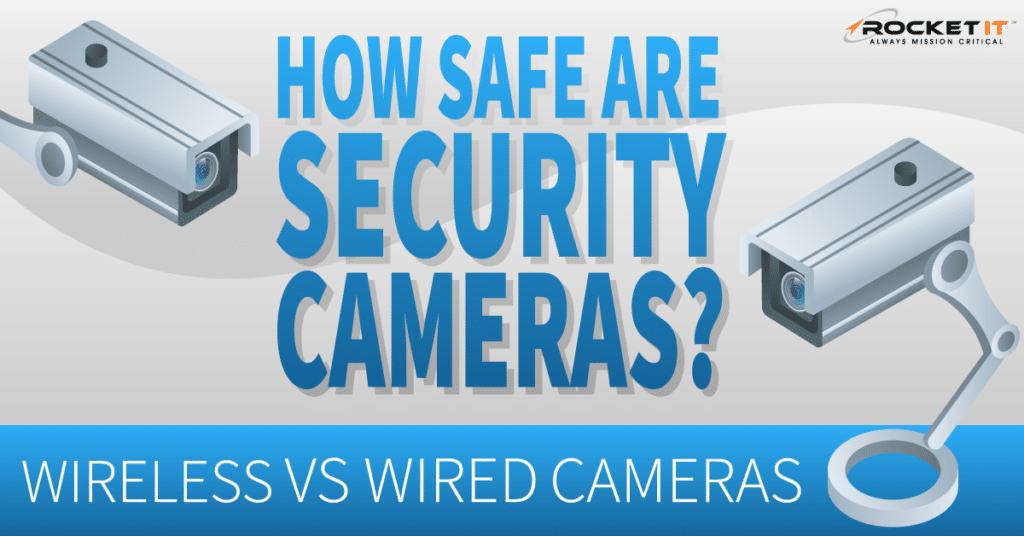How Safe are Security Cameras? Wireless VS Wired Cameras

Although Wi-Fi enabled cameras can quickly turn your office space or home into an affordable fortress of surveillance, cameras without proper security settings increase your chance of being hacked by 47 percent. And with an array of cameras currently on the market, Rocket IT is helping you determine which security features are the most important and what to consider when setting up your device.
Security Camera Features to Consider
From Arlo to Ring, there are plenty of security camera brands to choose from. But with so many options available, which features should you prioritize?
Before we dive straight into security, let’s first explore how the features available in wired camera setups compare to that of wireless camera ecosystems.
Pros and Cons of Wired Security Cameras
Convenience
Rather than each camera being powered by battery or standard wall outlets, wired cameras are powered by a central digital video recorder (DVR) or a networked video recorder (NVR). Because of this centralized hub, most wired camera systems lack mobile companion apps and won’t work well with smart devices, such as Google Assistant or Amazon Alexa. As a result, you’ll be forced to either hook up a monitor or download the recordings to review them.
Cost
If you choose to select this type of camera, be prepared to meticulously run cables throughout exterior or interior walls for the cameras to reach the hub. Should you not have experience with cable routing, hiring someone to do the job presents a higher upfront cost than wireless alternatives. But despite this potentially high upfront cost, owners of wired camera systems save in the long run as most wired security systems are equipped with enough hard drive space to store recorded footage locally for seven days. In turn, there’s no need to pay monthly or annual fees for cloud storage.
Privacy
Finally, because wired cameras rely on a localized connection, there’s usually no need for an Internet signal. As a result of this lack of online connectivity, cybercriminals would be hard pressed to gain access to your camera from afar.
Recap: Wired Security Camera Pros
- Higher upfront costs are offset by the ability to record footage locally
- Lack of internet connectivity decreases the chances of a successful hack
Recap: Wired Security Camera Cons
- Requires owners to route cables through walls
- Lack of cloud services and companion mobile apps makes it difficult to review footage from afar
Pros and Cons of Wireless Security Cameras
Convenience
Unlike their wired companions, wireless cameras are powered either by batteries or nearby electrical outlets and require a strong Wi-Fi signal. Rather than running cables throughout your home or office space, wireless cameras are far easier to mount and adjust when needed. Many of the top wireless cameras on the market offer cloud-based storage options and smartphone applications, making it convenient for owners to access their recorded footage and live video feed from afar.
Wireless cameras also tend to have more advanced features, including machine learning to alert owners of a delivered package and two-way audio capabilities to allow for remote communication. Furthermore, while fully wireless cameras will need to be charged every three months or so, most offer the option to record only when motion or sound is detected. As a result, this allows battery-powered devices to remain online longer than if it were recording 24 hours a day. Nevertheless, unless your Wi-Fi signal is strong, placing wireless cameras around a large home or office could result in lower video quality than that of a wired security system.
Cost
Another variable to consider with wireless cameras is cost. In wired security systems, the expensive technology is in the central recording hub. On the other hand, with a wireless ecosystem, the technology is typically located in each of the cameras you deploy. Because of this, wireless cameras tend to cost more than their wired counterparts. Additionally, keep in mind that the manufacturers of wireless cameras charge a fee to use their cloud storage features. And while some wireless cameras do allow for local storage via a micro-SD card, doing so is likely to limit some of the device’s features.
Privacy
Finally, since wireless cameras are completely reliant on an internet connection to operate, they are susceptible to being hacked if your network isn’t protected.
Recap: Wireless Security Camera Pros
- No need to route cables through walls, allowing for more placement options
- Accompanying cloud services and mobile apps allows for footage and live feeds to be reviewed while on the go
- Come packed with features for automation, voice assistants, and machine learning
- Firmware updates allow for more features to be added and vulnerabilities to be patched
Recap: Wireless Security Camera Cons
- Battery powered devices need to be charged every few months
- Weak Wi-Fi signals can cause spotty footage
- Most wireless cameras require a subscription to cloud storage, which can add up with multiple devices
- Reliance on the Internet means a higher likelihood of being hacked without proper security settings enabled
How to Keep Wireless Cameras Secure
Now that you’ve subjectively weighed the pros and cons of wired and wireless security cameras, let’s take a moment to focus strictly on privacy. If you’re like 34 perfect of United States citizens, it’s likely that you favor the convenience that wireless cameras present. But before you go and install wireless cameras throughout your home or office, it’s crucial to enable some key security settings on both your network and the security camera itself to ensure cybercriminals aren’t able to access your video feed.
Wi-Fi Settings to Review
Wi-Fi Protected Access
First and foremost, make sure your router has either Wi-Fi Protected Access (WPA) or Wi-Fi Protected Access 2 (WPA2) security. This ensures your wireless connections are far more secure than that of routers that rely on older encryption methods, such as Wired Equivalent Privacy (WEP). If you’re on a PC running Windows 10, you can easily check if your connected via WPA or WPA2 by clicking the Wi-Fi icon in your task bar, selecting properties under your connection, and scrolling down to view the security type.
Wi-Fi Password Protection
Just as you protect your online banking and shopping accounts with secure passwords, it’s important embrace a similar sense of caution when creating a password for your Wi-Fi network. For example, a combination of 12 lowercase and uppercase letters, numbers, and symbols can greatly improve the security of your home or business network. Also, remember that this password should be unique to this network and not used anywhere else online. To learn how to create the ultimate password, check out this guide from Rocket IT.
Wireless Security Camera Settings to Review
Security Camera Password Protection
In addition to creating a strong password for your Wi-Fi network, it’s important to also create a similarly efficient password for your security camera’s login portal. Typically, this step can be completed by opening your camera’s accompanying mobile app and navigating to account settings.
Multi-Factor Authentication
While you’re in your security camera’s mobile app, take a look to see if you can find a setting labeled either “multi-factor authentication” or “two-step verification”. By enabling this feature and adding a second layer of account protection, you can drastically reduce the risk of an unwelcomed guest gaining access to your network through an exposed camera. Whereas a standard password is something that many cybercriminals can crack, MFA typically relies on you having access to a specific smartphone when logging in. Depending on your security camera’s manufacturer, your method of authentication will vary, but typically it comes in the form of facial scanning, a push notification, or a changing PIN. For more information on multi-factor authentication, refer to this guide from Rocket IT.
Firmware Updates
When it comes to security breaches, many hackers gain access to networks through unknown vulnerabilities in the hardware or software of technologies. In turn, developers spend countless hours poring over their work in attempt to discover said vulnerabilities and deploy patches to resolve any potential areas for exploitation. Noting that the update process for many security cameras isn’t automated, it’s important to periodically check your camera’s app to see if updates are available. Typically, if an update is available, you’ll receive a prompt as you log in, but if not, head to your app’s settings menu and see if there’s an option to check for updates.
Geofencing
For those individuals that plan to place cameras inside, rather than on its exterior, geofencing is a helpful setting to consider enabling. When you create a geofence using your security camera’s app, you essentially create an invisible border around your home or office. In turn, when you and the smartphone tied to your security system enter the perimeter of that boundary, geofencing allows you to automate a variety of different settings. For example, geofencing can be used to snooze a camera feed when you enter the building, lessening the chances of prying eyes watching you lounge around. In turn, when you exit the geofence, the cameras will automatically return online, keeping your home or office safe while you’re away.
Physical Placement
Alternatively, if you’d prefer to not set up geofencing, make sure to refrain from placing cameras in private spaces, such as bedrooms and bathrooms. Furthermore, if your camera has a physical indication light that notifies you when it’s recording, make sure to place the camera in such a way that your view of the light is not obstructed.
Final Verdict
While wired security systems are the safest option for privacy, wireless cameras offer a more feature-rich and similarly safe experience if proper security settings are applied to the camera and its network. That said, keep in mind that securing your Wi-Fi and wireless security camera is only part of the battle. Because most wireless camera manufacturers store recorded footage in their cloud network, protecting your privacy also falls on the shoulders of the camera’s software development and data management teams. In turn, when selecting one of the many wireless cameras available, it’s important to do some research to determine if the manufacturer has experienced breaches or privacy concerns in recent years. To stay up to date on these breaches and trending cybersecurity news, sign up for Rocket IT’s newsletter using the button bellow.
Related Posts
Subscribe to Rocket IT's Newsletter
Stay up to date on trending technology news and important updates.

Find out if Rocket IT is the right partner for your team
Claim a free consultation with a technology expert.















